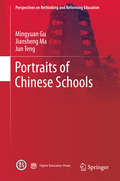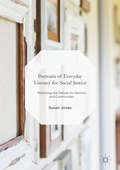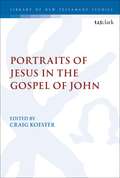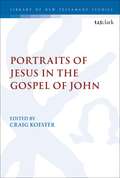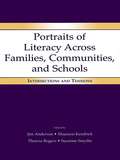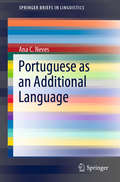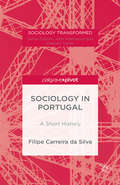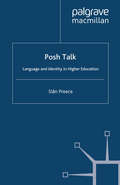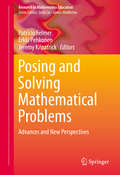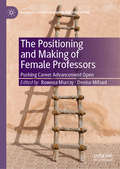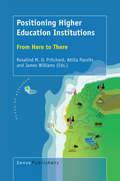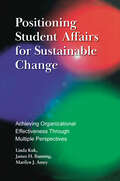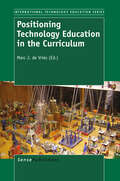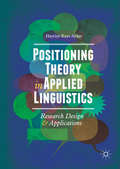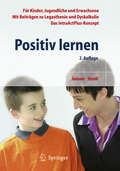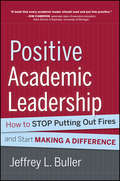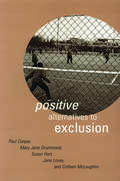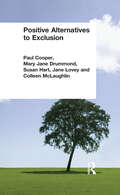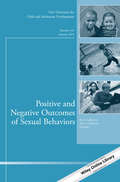- Table View
- List View
Portraits of Chinese Schools (Perspectives on Rethinking and Reforming Education)
by Mingyuan Gu Jiansheng Ma Jun TengThis book unravels the mysteries of the Chinese school system to enable international scholars to better understand the logic of basic education in China. By collecting the latest, first-hand empirical data, it outlines a panoramic and vivid portrait of Chinese schools from principals’, teachers’, students’ and parents’ perspectives, including descriptions of their daily lives. It also interprets different stakeholders’ duties and explains the unique characteristics and operation model of Chinese schools. It is of interest to all those who are concerned with the current situation and the future of the Chinese school system and basic education in China, especially international researchers, policymakers, and parents wanting to know what is really happening in schools.
Portraits of Everyday Literacy for Social Justice: Reframing the Debate for Families and Communities
by Susan JonesBased on an ethnographic study involving three families who live on a Midlands council housing estate, this book presents portraits of everyday lives - and the literacy practices that are part of them - as a way to explore the complex relationship between literacy and social justice. Each portrait focuses on a different aspect of literacy in everyday life: drawing on perspectives offered by the long and diverse tradition of literacy studies, each is followed by discussion of a different way of looking at literacy and what this means for social justice. The lens of literacy allows us to see the challenges faced by many families and communities as a result of social policy, and how a narrow view of literacy is often implicated within these challenges. It also illustrates the ways in which literacy practices are powerful resources in the creative and collaborative navigation of everyday lives.Arguing for the importance of looking carefully at everyday literacy in order to understand the intertwining factors that threaten justice, this book positions literary research and education as central to the struggle for wider social change. It will be of interest and value to researchers, educators and students of literacy for social justice.
Portraits of Everyday Literacy for Social Justice: Reframing the Debate for Families and Communities
by Susan JonesBased on an ethnographic study involving three families who live on a Midlands council housing estate, this book presents portraits of everyday lives - and the literacy practices that are part of them - as a way to explore the complex relationship between literacy and social justice. Each portrait focuses on a different aspect of literacy in everyday life: drawing on perspectives offered by the long and diverse tradition of literacy studies, each is followed by discussion of a different way of looking at literacy and what this means for social justice. The lens of literacy allows us to see the challenges faced by many families and communities as a result of social policy, and how a narrow view of literacy is often implicated within these challenges. It also illustrates the ways in which literacy practices are powerful resources in the creative and collaborative navigation of everyday lives.Arguing for the importance of looking carefully at everyday literacy in order to understand the intertwining factors that threaten justice, this book positions literary research and education as central to the struggle for wider social change. It will be of interest and value to researchers, educators and students of literacy for social justice.
Portraits of Influential Chinese Educators (CERC Studies in Comparative Education #17)
by Ruth HayhoeThis book conveys an understanding of China’s educational development from within and provides unique insights into Chinese society. It does so through portraits of eleven influential educators whose ideas have shaped the educational reforms initiated by Deng Xiaoping in 1978. The book makes Chinese civilization concrete through the drama of the real lives of educators and provides glimpses into the educational context of China’s recent move onto the world stage.
Portraits of Jesus in the Gospel of John (The Library of New Testament Studies)
by Craig KoesterJohn's Gospel is best known for its presentation of Jesus as the Word of God made flesh. But as the narrative unfolds, readers discover that the identity of Jesus is surprisingly complex. He is depicted as a teacher, a healer, a prophet, and Messiah. He is Jewish and Galilean, a human being who is Son of Man and Son of God. Portraits of Jesus considers each of these roles in detail, showing how each makes a distinctive contribution to the Gospel's rich mosaic of images for Jesus. John's multifaceted portrait of Jesus draws on a broad spectrum of early Christian traditions. Contributors to this collection of essays explore the ways in which these traditions are both preserved and transformed in the Fourth Gospel. The writers draw us more deeply into the questions of the way in which traditions about Jesus developed in the early church and how the Gospel of John might contribute to our understanding of that dynamic process.
Portraits of Jesus in the Gospel of John (The Library of New Testament Studies)
by Craig R. KoesterJohn's Gospel is best known for its presentation of Jesus as the Word of God made flesh. But as the narrative unfolds, readers discover that the identity of Jesus is surprisingly complex. He is depicted as a teacher, a healer, a prophet, and Messiah. He is Jewish and Galilean, a human being who is Son of Man and Son of God. Portraits of Jesus in the Gospel of John considers each of these roles in detail, showing how each makes a distinctive contribution to the Gospel's rich mosaic of images for Jesus. John's multifaceted portrait of Jesus draws on a broad spectrum of early Christian traditions, and the contributors to this collection of essays explore the ways in which these traditions are both preserved and transformed in the Fourth Gospel. The writers draw us more deeply into the questions of the way in which traditions about Jesus developed in the early church and how the Gospel of John might contribute to our understanding of that dynamic process.
Portraits of Literacy Across Families, Communities, and Schools: Intersections and Tensions
by Jim Anderson Maureen Kendrick Theresa Rogers Suzanne SmytheDesigned to stimulate debate and critical thinking and to draw readers' attention to the ideological nature of literacy education across a broad range of literacy contexts, this book crosses traditional boundaries between the study of family, community, and school literacies to offer a unique global perspective on multiple literacies, from theory to case studies of various settings. These examples suggest ways that literacy practices should be created by simultaneously shaping relationships and identity, and by privileging particular literacy practices in particular situations. The dialogue within the book among chapter authors writing across traditionally distinct fields highlights the interconnections among diverse literacy sites and stimulates the pursuit of a more integrated and interdisciplinary approach to literacy education. The critical and dialogic approach serves to challenge and extend many conventional notions surrounding literacy education in communities, schools, and families.Portraits of Literacy Across Families, Communities, and Schools: Intersections and Tensions is particularly relevant for scholars and students in the area of literacy, broadly speaking, including family literacy, community literacy, adult literacy, critical language studies, multiliteracies, youth literacy, English as a second language, language and social policy, and global literacy. Additionally, the inclusion of studies derived from a variety of research methods and designs makes this is a useful text in research methodology courses that aim to present and analyze real-life examples of literacy research designs and methods.
Portraits of Literacy Across Families, Communities, and Schools: Intersections and Tensions
by Jim Anderson Maureen Kendrick Theresa Rogers Suzanne SmytheDesigned to stimulate debate and critical thinking and to draw readers' attention to the ideological nature of literacy education across a broad range of literacy contexts, this book crosses traditional boundaries between the study of family, community, and school literacies to offer a unique global perspective on multiple literacies, from theory to case studies of various settings. These examples suggest ways that literacy practices should be created by simultaneously shaping relationships and identity, and by privileging particular literacy practices in particular situations. The dialogue within the book among chapter authors writing across traditionally distinct fields highlights the interconnections among diverse literacy sites and stimulates the pursuit of a more integrated and interdisciplinary approach to literacy education. The critical and dialogic approach serves to challenge and extend many conventional notions surrounding literacy education in communities, schools, and families.Portraits of Literacy Across Families, Communities, and Schools: Intersections and Tensions is particularly relevant for scholars and students in the area of literacy, broadly speaking, including family literacy, community literacy, adult literacy, critical language studies, multiliteracies, youth literacy, English as a second language, language and social policy, and global literacy. Additionally, the inclusion of studies derived from a variety of research methods and designs makes this is a useful text in research methodology courses that aim to present and analyze real-life examples of literacy research designs and methods.
Portuguese as an Additional Language (SpringerBriefs in Linguistics)
by Ana C. NevesThis book focuses on Portuguese as an additional language and its young learners in threecase studies within the Portuguese-speaking world: Portuguese as a second language inCape Verde, Portuguese as a heritage language in Switzerland and Portuguese as a foreignlanguage in Macao SAR. The term “additional language” is used as an umbrella term for allthree contexts.An analysis of these three case studies is presented, with a focus on the organization of explicit and implicit language policies with regards to population mobility and also motivational issues, language attitudes and language use by the sample population.
Portuguese Sociology: A History (Sociology Transformed)
by Filipe Carreira da SilvaSociology in Portugal provides the first English-language account of the history of sociology in Portugal from 1945 to the present day. Banned by the fascist regime until 1974, the institutionalization of sociology as an academic discipline came relatively late. Understanding academic disciplines as institutionalized struggles over meaning, Filipe Carreira da Silva gives a genealogy of sociology in Portugal from its origins in the political-administrative interstices of a dictatorship, through the 'cyclopean moment' of the political revolution of April 1974, which brought about its swift institutionalization and subsequent consolidation in the new democratic regime, to the challenges posed by internationalization since the 1990s. Attempts to define Portugal itself, he demonstrates, have been at the heart of these struggles. Analyzing agents, institutions, contexts, instruments and ideas, Carreira da Silva shows in fascinating detail how the sociological understanding of Portugal evolved from that of a developing society in the 1960s, to that of a modernizing European social formation in the 1980s, to the post-colonial or post-imperial Portugal of today.
Posh Talk: Language and Identity in Higher Education
by S. PreeceAn in-depth study of a group of multilingual students from widening participation backgrounds on a first-year undergraduate academic writing programme. The book explores ways in which identity positions emerge in the spoken interaction, with a particular focus on gender.
Posing and Solving Mathematical Problems: Advances and New Perspectives (Research in Mathematics Education #0)
by Patricio Felmer Erkki Pehkonen Jeremy KilpatrickThis book collects recent research on posing and solving mathematical problems. Rather than treating these two crucial aspects of school mathematics as separate areas of study, the authors approach them as a unit where both areas are measured on equal grounds in relation to each other. The contributors are from a vast variety of countries and with a wide range of experience; it includes the work from many of the leading researchers in the area and an important number of young researchers. The book is divided in three parts, one directed to new research perspectives and the other two directed to teachers and students, respectively.
Positionen.Entwicklungen.Erfahrungen – 10 Jahre Junge Opern Rhein-Ruhr: Dokumentation der Konferenz zum Festival „Auf die Ohren, fertig, los!“
by Christiane Plank-Baldauf Merle FahrholzHören, Sehen, Staunen – in den deutschsprachigen Opernhäusern kann junges Publikum seit über zehn Jahren viel entdecken! Die vorliegende Dokumentation fasst die Ergebnisse der Konferenz „Auf die Ohren, fertig los!“ der Jungen Opern Rhein-Ruhr zusammen und gibt Einblicke in künstlerische Produktionsbedingungen, ästhetische Handschriften, Vermittlungsarbeit, institutionelle Rahmenbedingungen und fokussiert aktuelle Uraufführungen des Kooperationsverbunds. Die Ergebnisse der Konferenz werden zudem in einen übergreifenden Kontext gesellschafts- und kulturpolitischer Entwicklungen im Musiktheater für junges Publikum im deutschsprachigen Raum gestellt.
The Positioning and Making of Female Professors: Pushing Career Advancement Open (Palgrave Studies in Gender and Education)
by Rowena Murray Denise MifsudThis book explores the experiences and perspectives of female professors. Analysing the gendering of this process using various theoretical perspectives, this edited collection examines the active ‘making’ of careers, and how this has been possible. The editors and contributors cut across institutions, cultures and continents to seek to understand how women navigate the gendered process of becoming a professor, with each chapter applying a different theoretical or methodological approach to her experience. The chapters are not mere descriptions of career trajectories, but analytic narratives anchored within distinct theoretical and philosophical frameworks. In turn, they shed important light on how – and if – institutional structures and systems are adapting to move towards gender equality. Offering practical advice as well as thoughtful reflection, this book will be of especial interest to early career female academics.
Positioning Higher Education Institutions: From Here to There
by Rosalind M. O. Pritchard Attila Pausits James WilliamsHigher education is of growing public and political importance for society and the economy. Globalisation is transforming it from a local and national concern into one of international significance. In order to fulfil societal, governmental and business sector needs, many universities are aiming to (re-)position themselves. The book initially considers their “compass”. They aspire to transformational planning, mission and strategy in which social justice is important, people are not treated as mere means to an end, and traditional moral positions are respected. This transformational urge is sometimes vitiated by blunt demands of new public management that overlook universities’ potential for serving the public good. The volume then addresses universities’ success in meeting their targets. Often the challenge in evaluation is the need to reconcile tensions, for example between structure and pastoral care of students; institutional competition and collaboration; roles of academics and administrators; performance-based funding versus increased differentiation. Measurement is supposed to provide discipline, align institutional and state policy, and provide a vital impetus for change. Yet many of these measurement instruments are not fully fit for purpose. They do not take sufficient account of institutional missions, either of “old” or of specialist universities; and sophisticated measurement of the student experience requires massive resources. Change and positioning have become increasingly key elements of a complex but heterogeneous sector requiring new services and upgraded instruments.
Positioning Student Affairs for Sustainable Change: Achieving Organizational Effectiveness Through Multiple Perspectives
by Linda Kuk James H. Banning Marilyn J. AmeyAt a time of increasing student diversity, concern about security, demand for greater accountability, and of economic difficulty, what does the future hold for higher education, and how can student affairs organizations adapt to the increasing and changing demands? How can university leaders position existing resources to effectively address these and other emerging challenges with a sense of opportunity rather than dread? How can organizations be redesigned to sustain change while achieving excellence?As student affairs organizations have grown and become increasingly complex in order to meet new demands, they have often emphasized the expansion of their missions to the detriment of focusing on understanding their roles in relationship to other units, to reviewing their cultures and structures, and to considering how they can improve their effectiveness as organizations. This book provides the tools for organizational analysis and sustainability.Intended for practitioners, graduate students, interns and student affairs leaders, this book presents the key ideas and concepts from business-oriented organizational behavior and change theories, and demonstrates how they can be useful in, and be applied to, student affairs practice – and, in particular, how readers can use these theories to sustain change and enhance their organization’s ability to adapt to complex emerging challenges. At the same time it holds to values and perspectives that support the human dimension of organizational life.Recognizing the complexity of today’s organizations and the value of viewing them from multiple perspectives, this book follows the emerging practice of providing three general epistemological perspectives – the Positivist, Social Constructionist, and Postmodernist – for analyzing often paradoxical organizational structures, environments, and behavior.The book explores the environmental context of student affairs, and how the organization interacts with both the internal and external environments; examines the human dimension of organizations, through a review of individual attributes, human need and motivation, social comparison theory and organizational learning theory; presents the dimensions of structure and design theory and discusses why student affairs organizations need to think differently about how they organize their resources; considers the context and process of organizational change, and the dynamics of decision making, power, conflict and communication; addresses the role of assessment and evaluation; and new forms of leadership.Each chapter opens with a case study, and closes with a set of reflective questions.The authors have all served as practitioners within student affairs and now teach and advise graduate students and future leaders in the field.
Positioning Student Affairs for Sustainable Change: Achieving Organizational Effectiveness Through Multiple Perspectives
by Linda Kuk James H. Banning Marilyn J. AmeyAt a time of increasing student diversity, concern about security, demand for greater accountability, and of economic difficulty, what does the future hold for higher education, and how can student affairs organizations adapt to the increasing and changing demands? How can university leaders position existing resources to effectively address these and other emerging challenges with a sense of opportunity rather than dread? How can organizations be redesigned to sustain change while achieving excellence?As student affairs organizations have grown and become increasingly complex in order to meet new demands, they have often emphasized the expansion of their missions to the detriment of focusing on understanding their roles in relationship to other units, to reviewing their cultures and structures, and to considering how they can improve their effectiveness as organizations. This book provides the tools for organizational analysis and sustainability.Intended for practitioners, graduate students, interns and student affairs leaders, this book presents the key ideas and concepts from business-oriented organizational behavior and change theories, and demonstrates how they can be useful in, and be applied to, student affairs practice – and, in particular, how readers can use these theories to sustain change and enhance their organization’s ability to adapt to complex emerging challenges. At the same time it holds to values and perspectives that support the human dimension of organizational life.Recognizing the complexity of today’s organizations and the value of viewing them from multiple perspectives, this book follows the emerging practice of providing three general epistemological perspectives – the Positivist, Social Constructionist, and Postmodernist – for analyzing often paradoxical organizational structures, environments, and behavior.The book explores the environmental context of student affairs, and how the organization interacts with both the internal and external environments; examines the human dimension of organizations, through a review of individual attributes, human need and motivation, social comparison theory and organizational learning theory; presents the dimensions of structure and design theory and discusses why student affairs organizations need to think differently about how they organize their resources; considers the context and process of organizational change, and the dynamics of decision making, power, conflict and communication; addresses the role of assessment and evaluation; and new forms of leadership.Each chapter opens with a case study, and closes with a set of reflective questions.The authors have all served as practitioners within student affairs and now teach and advise graduate students and future leaders in the field.
Positioning Technology Education in the Curriculum (INTERNATIONAL TECHNOLOGY EDUCATION SERIES #8)
by Marc J. De VriesThe position of technology education in the school curriculum is a topic of continuous discussions. This book offers a number of research-based contributions to that discussion. A number of aspects have been identified that are related to the way technology education can be embedded in the curriculum: The historical development of the subject, its disciplinary character, its relation to other parts of the curriculum, and in particular with science and language education, the relation between the formal school curriculum and informal learning, forms of progression over the grades, and its contribution to citizenship, forms of literacy and ethics. The final chapter deals with specific issues for developing countries. The book can support decision making on the curriculum and the development of technology education as a part of that by providing theoretical and empirical insights on this topic.
Positioning Theory in Applied Linguistics: Research Design and Applications
by Hayriye Kayı-AydarThis book is about Positioning Theory (Davies & Harré, 1990) and its potential applications in bilingual and multilingual contexts involving teachers, learners, speakers, and users of a second/foreign or additional language. By using Positioning Theory as a theoretical lens and analytical approach, the author illustrates how various social and poststructural concepts in applied linguistics and language teacher education, including identity, agency, language socialization, classroom participation, and intercultural communication, can be investigated and better understood. The book adds a new perspective to the growing body of multidisciplinary literature in the areas of L2 teacher education and classroom learning, and includes step-by-step guidelines for positioning analysis, insights and implications for classroom practice, as well as suggested directions for future research. It will be of particular interest to language teachers and teacher educators, as well as students and scholars of applied linguistics more broadly.
Positiv lernen
by Fritz Jansen Uta StreitLern- und Leistungsstörungen sind eine enorme Belastung für Betroffene sowie ihre Bezugspersonen. Die Autoren zeigen, was man dagegen tun kann: Mit ihrem IntraActPlus-Konzept nutzen sie die Erkenntnisse aus der psychologischen Grundlagenforschung und richten sich an Eltern, aber auch Lehrer, Ergotherapeuten, Schulpsychologen und andere Berufsgruppen, die mit Kindern arbeiten. – Wie entstehen Lernstörungen, wie verfestigen sie sich, wie kann man ihnen vorbeugen? Konkrete Handlungsanweisungen garantieren die praktische Nutzbarkeit des Ratgebers. Mit Kapiteln zu Legasthenie, Dyskalkulie und dem Einsatz in der Schule.
Positive Academic Leadership: How to Stop Putting Out Fires and Start Making a Difference (Jossey-Bass Resources for Department Chairs #142)
by Jeffrey L. Buller"A book that every academic leader should read and put into practice." —Kim Cameron, associate dean of executive education, Ross School of Business, University of Michigan Praise for Positive Academic Leadership " Buller has produced a book that every academic leader should read and put into practice. Positive Academic Leadership pulls together an amazing array of scientific findings and practical guidelines that will be invaluable for academic leaders looking to improve themselves and their institutions." — Kim Cameron, associate dean, William Russell Professor of Management and Organizations, Ross School of Business; professor of higher education, School of Education, University of Michigan " If I had a magic wand and could make one wish for all of higher education, it would be that we had better institutional leadership. Whether one is a chair, dean, provost, president, or on the Board of Trustees, this book can make a world of difference in your ability to provide that leadership!" — L. Dee Fink, author, Creating Significant Learning Experiences; former president, Professional and Organizational Development Network in Higher Education " Buller's book brings hope for leadership in higher education by emphasizing the importance of a positive approach that empowers and inspires others. Positive Academic Leadership has the potential to transform higher education for the benefit of students, faculty, and ultimately our communities and our world." — Kina S. Mallard, provost and vice president of academic affairs, Carson-Newman University " Academic leaders who find themselves engulfed in negative thinking and considering only damage control scenarios for pressing issues will want to read this book. Employing what Jeffrey Buller calls 'positive academic leadership' is, I believe, essential to transforming feelings of despair into constructive leadership." — Mary Lou Higgerson, vice president for academic affairs, emerita, Baldwin Wallace University " I can't recall reading any book on leadership that is more applicable to the work of faculty development. Every academic leader—faculty member, chair, dean, or campus administrator—will benefit from Jeffrey Buller's evidence-based model and practices of positive academic leadership." — Mary Deane Sorcinelli, associate provost for faculty development, University of Massachusetts Amherst
Positive Academic Leadership: How to Stop Putting Out Fires and Start Making a Difference (Jossey-Bass Resources for Department Chairs)
by Jeffrey L. Buller"A book that every academic leader should read and put into practice." —Kim Cameron, associate dean of executive education, Ross School of Business, University of Michigan Praise for Positive Academic Leadership " Buller has produced a book that every academic leader should read and put into practice. Positive Academic Leadership pulls together an amazing array of scientific findings and practical guidelines that will be invaluable for academic leaders looking to improve themselves and their institutions." — Kim Cameron, associate dean, William Russell Professor of Management and Organizations, Ross School of Business; professor of higher education, School of Education, University of Michigan " If I had a magic wand and could make one wish for all of higher education, it would be that we had better institutional leadership. Whether one is a chair, dean, provost, president, or on the Board of Trustees, this book can make a world of difference in your ability to provide that leadership!" — L. Dee Fink, author, Creating Significant Learning Experiences; former president, Professional and Organizational Development Network in Higher Education " Buller's book brings hope for leadership in higher education by emphasizing the importance of a positive approach that empowers and inspires others. Positive Academic Leadership has the potential to transform higher education for the benefit of students, faculty, and ultimately our communities and our world." — Kina S. Mallard, provost and vice president of academic affairs, Carson-Newman University " Academic leaders who find themselves engulfed in negative thinking and considering only damage control scenarios for pressing issues will want to read this book. Employing what Jeffrey Buller calls 'positive academic leadership' is, I believe, essential to transforming feelings of despair into constructive leadership." — Mary Lou Higgerson, vice president for academic affairs, emerita, Baldwin Wallace University " I can't recall reading any book on leadership that is more applicable to the work of faculty development. Every academic leader—faculty member, chair, dean, or campus administrator—will benefit from Jeffrey Buller's evidence-based model and practices of positive academic leadership." — Mary Deane Sorcinelli, associate provost for faculty development, University of Massachusetts Amherst
Positive Alternatives to Exclusion
by Paul Cooper Mary Jane Drummond Susan Hart Jane Lovey Colleen McLaughlinPositive Alternatives to School Exclusion looks at what schools can do to build more harmonious communities and engage students - particularly those at risk of exclusion - more productively in all areas of school life. It describes the Positive Alternatives to School Exclusion Project, a multi-phase, collaborative initiative based at the School of Education, University of Cambridge.Drawing on the perspectives of staff and pupils, the authors provide detailed case studies of the approaches and strategies being adopted in a variety of settings (primary, secondary and FE) to foster inclusion and reduce and prevent exclusion. It also identifies a number of different frameworks, drawn from the case studies, which can be used by practitioners working in other settings to support their own reflection and development work. Particular importance is placed, throughout the book, on valuing the domain of personal experience in the life of the school community. The authors explore this theme in detail, suggesting ways in which it might become a priority focus of further development work in schools.
Positive Alternatives to Exclusion
by Paul Cooper, Mary Jane Drummond, Susan Hart, Jane Lovey and Colleen McLaughlinPositive Alternatives to School Exclusion looks at what schools can do to build more harmonious communities and engage students - particularly those at risk of exclusion - more productively in all areas of school life. It describes the Positive Alternatives to School Exclusion Project, a multi-phase, collaborative initiative based at the School of Education, University of Cambridge.Drawing on the perspectives of staff and pupils, the authors provide detailed case studies of the approaches and strategies being adopted in a variety of settings (primary, secondary and FE) to foster inclusion and reduce and prevent exclusion. It also identifies a number of different frameworks, drawn from the case studies, which can be used by practitioners working in other settings to support their own reflection and development work. Particular importance is placed, throughout the book, on valuing the domain of personal experience in the life of the school community. The authors explore this theme in detail, suggesting ways in which it might become a priority focus of further development work in schools.
Positive and Negative Outcomes of Sexual Behaviors: New Directions for Child and Adolescent Development, Number 144 (J-B CAD Single Issue Child & Adolescent Development)
by Eva S. Lefkowitz Sara A. VasilenkoDeveloping healthy sexual behaviors is critical to adolescents’ wellbeing. While more emphasis has been on negative outcomes, there are broad positive implications for physical health, mental health, intimate relationships, and identity development. To fully understand the impact, we need to understand both. In addition, the impact of sexual behavior is not universal, but may differ based on individuals’ demographic, relational, contextual, and attitudinal factors. This volume provides a framework for understanding the complex role of sexual behavior in adolescents’ lives, with a specific focus on the roles of sexual minority status, internet-based sexual experiences, relationship context, and sexual learning through formal and informal sex education in determining the outcomes of sexual behavior. It provides: A nuanced, multidimensional understanding of the role of sexual behavior in shaping adolescents’ development and well-being Important directions for future research Recommendations for sexuality education, prevention, and intervention programs. This is the 144th volume in this Jossey-Bass series New Directions for Child and Adolescent Development. Its mission is to provide scientific and scholarly presentations on cutting edge issues and concepts in this subject area. Each volume focuses on a specific new direction or research topic and is edited by experts from that field.
